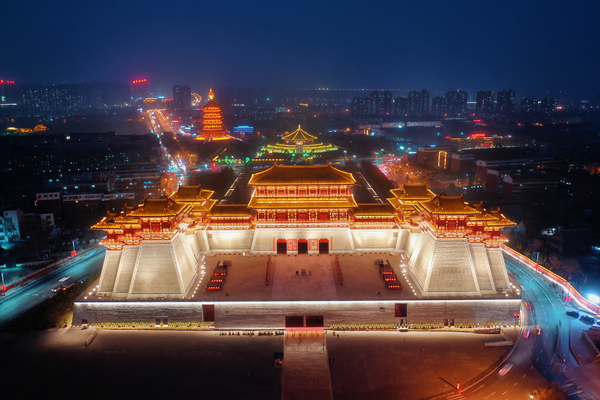Towards Civilization⑫|City ruins of Luoyang from Sui to Tang dynasties
"We should attach more importance to and put more efforts on archaeological research to carry forward the project of tracing the origins of Chinese civilization," stressed Chinese President Xi Jinping during his recent inspection tour to Anyang city, Henan province. Henan, cradle of the Chinese nation and civilization, is not only the birthplace of modern Chinese archaeology, but also the core area for tracing the origins of Chinese civilization. Together with the Development and Reform Commission of Henan Province and the Administration of Cultural Heritage of Henan Province, we are launching the "Towards Civilization" bilingual series featuring 13 key archaeological sites in Henan to help you catch a glimpse of wonderful Henan and brilliant Chinese civilization. Here is the 12th episode of the series: City ruins of Luoyang from Sui to Tang dynasties.
近日,习近平总书记考察了殷墟遗址,提出考古工作要继续重视和加强,继续深化中华文明探源工程。河南是中华民族和中华文明的重要发祥地,中国现代考古学从河南起步,中华文明探源从河南开始。2022年11月5日起,大河网联合省发展改革委、省文物局推出《追寻文明的足迹》系列报道,一起走进厚重河南。今日推出第十二期:《隋唐神韵 繁华东都——隋唐洛阳城遗址》。
Click on the video
With high historical, scientific and artistic values, the City Ruins of Luoyang from Sui to Tang Dynasties is a relatively well-preserved large-scale ruins of an ancient city in the dynasties of Sui (581-618) and Tang (618-907).
隋唐洛阳城遗址是中国现存隋唐时期保存较为完整的大型古代城市遗址,具有突出的历史价值、科学价值和艺术价值。

Part of the city ruins. [Photo provided to dahe.cn]
Distributed along the Luohe River and covering an area of about 47 square kilometers, the city ruins once served as the capital of Yang Guang (605-616), the second emperor of the Sui Dynasty. With Yique (Longmen in present day) in its south, the Mangshan Mountain in its north and the Luohe River flowing through, Luoyang was the starting point of the Silk Road in the East and a hub of the Grand Canal of Sui and Tang Dynasties. Luoyang's population during the two dynasties already exceeded 1 million. Since Yang Guang moved the capital eastward to Luoyang, the city was named Dongjing, Dongdu, Luoyanggong, Shendu and Xijing successively in its over 530 years of history of being a capital of different dynasties, witnessing the most prosperous period of China's feudal society. It is a valuable heritage for the study of the capital construction, urban layout, social life and other aspects of ancient China, and its layout and architectural form had a far-reaching influence on later dynasties.
隋唐洛阳城位于今洛阳市区洛河两岸,始建于隋大业元年(公元605年),面积约47平方公里,南面伊阙,北依邙山,左瀍右涧,洛水贯其中,是丝绸之路的东方起点,隋唐大运河的中心枢纽。隋唐两代,洛阳的都城人口达百万。自隋炀帝迁都,该城先后被称作东京、东都、洛阳宫、神都、西京,历经隋、唐、五代、北宋,跨越了中国封建社会的最鼎盛时期,前后沿用530多年,是研究中国古代都城建制、城市布局、社会生活等方面的宝贵遗产,其平面布局、建筑形制对后世影响深远。

Yingtianmen Gate. [Photo provided to dahe.cn]
Since the 1950s, archeologists have carried out in-depth investigations and excavations here and basically made the location, scale and overall layout of it clear. In 1988, the site was put by the State Council as one of the third batch of national key cultural relic protection units.
20世纪50年代以来,考古工作者在隋唐洛阳城范围内,进行了深入的文物调查和考古发掘,已基本探明了隋唐洛阳城城址的位置、规模以及整体布局。1988年,该遗址被国务院公布为第三批全国重点文物保护单位。(编译/赵汉青 播音/杨佳欣 视频/何蒙贺 审校/陈行洁)
Related stories
相关阅读
Towards Civilization①|Jiahu site, where Chinese civilization starts
Towards Civilization②|Yangshao village, birthplace of modern Chinese archaeology
Towards Civilization③|Miaodigou witnessed the prosperity of Yangshao Culture
追寻文明的足迹③|仰韶文化繁荣期的“文明之花”——庙底沟遗址
Towards Civilization④|Ancient 'Heluo Kingdom' in Gongyi, Henan
Towards Civilization⑤|Dahecun: a shining pearl of Yangshao Culture
Towards Civilization⑥|Discover earliest China at Erlitou site in Luoyang, Henan
Towards Civilization⑩|Capital city ruins of Eastern Zhou Dynasty in Luoyang
Towards Civilization⑪|City ruins of Luoyang from Eastern Han to Northern Wei dynasties
Towards Civilization⑬|Dongjing: An international metropolitan city during the Middle Ages
